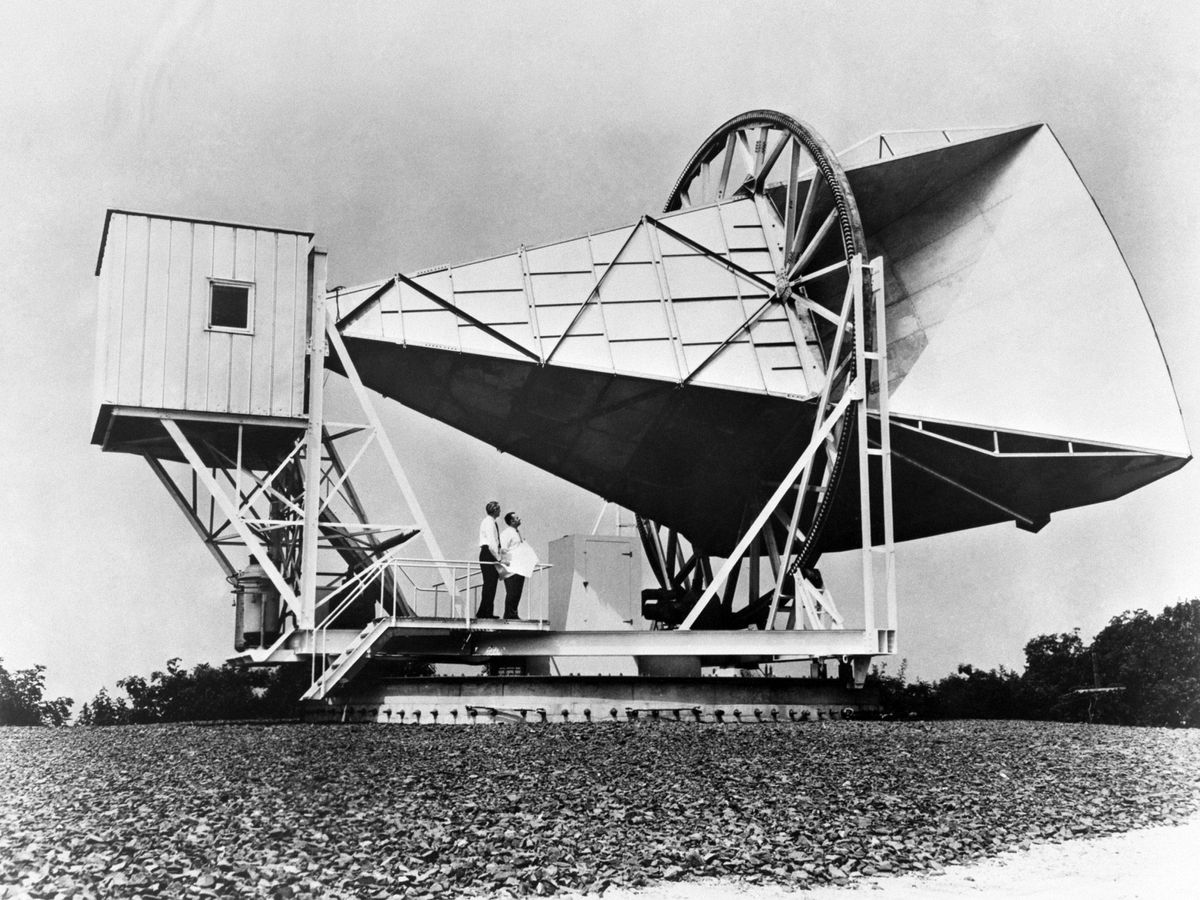The antenna that discovered a cosmic microwave background coming from all directions in space—cementing the theory that the universe was created in a big bang—now stares down its own topsy-turvy future. Its owner says the hardware will be preserved, but the fate of the historical site itself is far from assured.
In 1964, Bell Labs radio astronomers Arno Penzias and Robert Wilson were mapping radio signals from the Milky Way using the company’s supersensitive 20-foot-tall horn-shaped antenna in Holmdel, N.J. Despite painstaking attempts to eliminate any noise in their readings, they continually detected an unexpected buzz coming from all parts of the sky at all times of the day and night.
“This is a particularly important site in the history of science, the place where the echoes of the big bang were first detected. And preservation in some form is important.”
—Lee Sawyer, Louisiana Tech University
“They even went so far as to take rags and detergents to carefully wash the antenna from the droppings of a pair of pigeons that had nested there,” says Leonardo Colletti, a professor of physics education and the history of physics at the Free University of Bozen-Bolzano, Italy. “Doing the dirty work, all the way.”
These signals turned out to be the cosmic microwave background radiation that permeates the universe. These leftovers from the birth of the cosmos helped confirm its origins in a big bang, a discovery that won Penzias and Wilson the Nobel Prize in Physics in 1978.
Here was where the big bang was discovered
However, in 2021, Nokia sold the area in which the Holmdel Horn Antenna is located to technology entrepreneur Rakesh Antala. The roughly 43-acre site cost about US $3.6 million, says real estate broker Doug Twyman, a senior managing director at Colliers International in Woodbridge, N.J, who handled the transaction.
The site is currently zoned only for research, Twyman says. However, in December, the Holmdel Planning Board voted to undertake a study to consider reclassifying the site as an area in need of redevelopment, alarming local citizen groups.
“This raises the question of whether the town is considering development of the site, which could lead to removal or destruction of the irreplaceable historical horn,” notes the Citizens for Informed Land Use. This group, along with fellow nonprofits Friends of Holmdel Open Space and Preserve Holmdel, is working to preserve the antenna and keep it intact in its original location.
The Holmdel Horn Antenna was named a National Historic Landmark in 1989. However, this designation “is more of an honor than a protection,” says Janet Jackel, a physicist, former Bell Labs employee, IEEE Fellow, and president of Friends of Holmdel Open Space.
The antenna’s lack of legal protection led the citizen groups to start a petition to save the antenna. The appeal has gathered more than 6,700 signatures from across the world so far.
“This is a particularly important site in the history of science, the place where the echoes of the big bang were first detected. And preservation in some form is important,” says Lee Sawyer, a physicist at Louisiana Tech University.
One possibility for the area is to preserve the area as a park and historic site. The antenna sits on top of Crawford Hill, the highest point of Monmouth County in New Jersey, offering picturesque views of Raritan Bay and Manhattan, says Ralph Blumenthal, a physicist, former Bell Labs employee, and trustee of Friends of Holmdel Open Space.
The site could also host an education center for astronomy and cosmology, says Fred Carl, founder of the InfoAge Science & History Museums in Wall, N.J. In addition, “people at the IEEE History Center say they have lots and lots of material from the history of science and technology from there,” Jackel says. “Crawford Hill wasn’t just a site important for radio astronomy but also optical communications.”
Antala says the “Horn Antenna will be preserved.”
However, such assurances do not necessarily preclude the antenna itself being removed from its site, Blumenthal says. Plymouth Rock, he notes, would just be another rock if it were removed from its original site. Both location and artifact would suffer from a separation of one from the other.
Blumenthal adds that one countervailing force could be the Holmdel Township Committee possibly working together with county, state, and other groups to buy the Horn Antenna site.
Blumenthal says he expects the study from the Holmdel Planning Board, which could help rezone the site for development, to take two to four more months. “If the town does not rezone the site, it may change how the current owner looks at it economically,” he says. “We want to work on convincing the town about the potential benefits of preservation.”
Charles Q. Choi is a science reporter who contributes regularly to IEEE Spectrum. He has written for Scientific American, The New York Times, Wired, and Science, among others.



